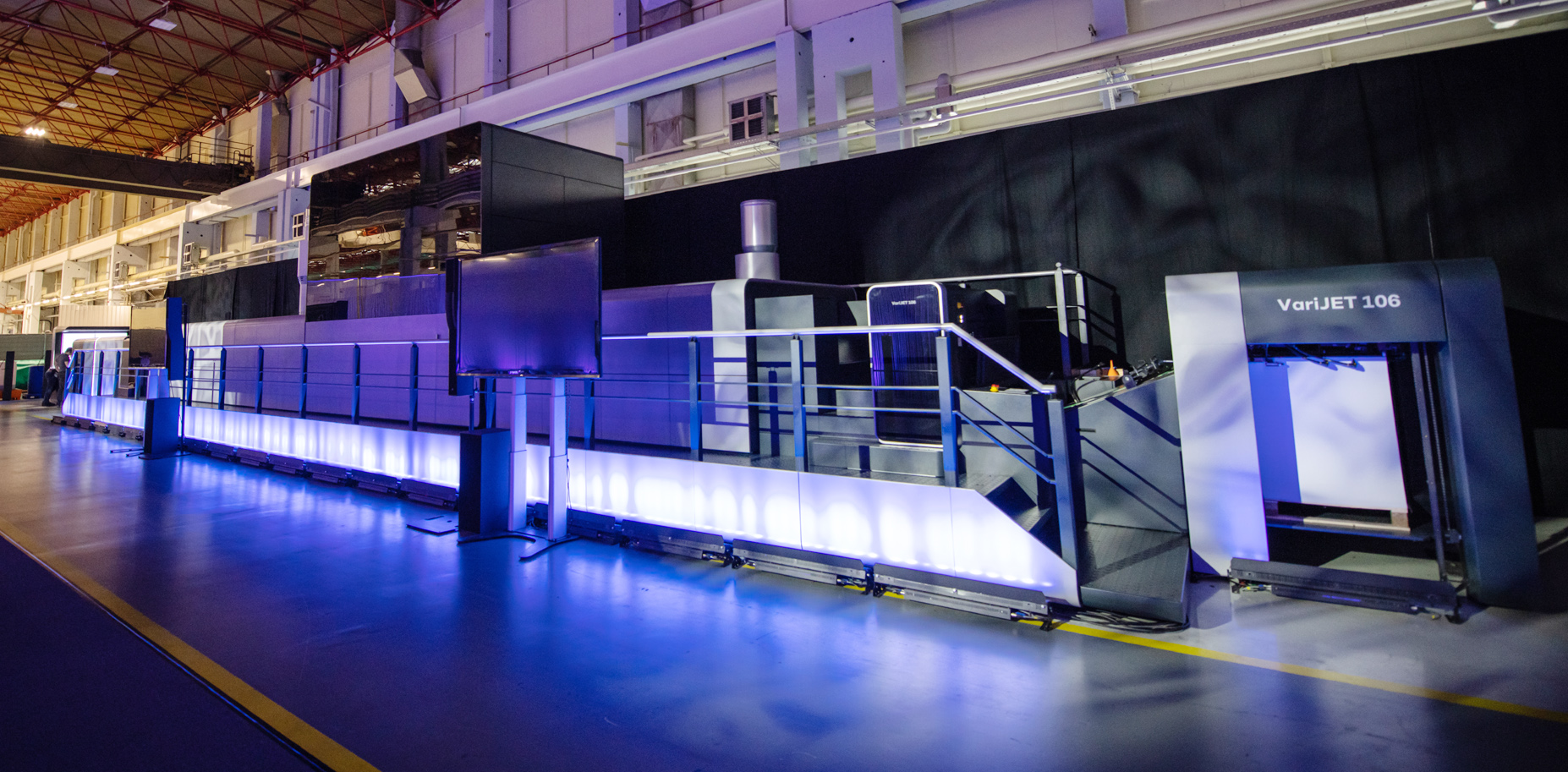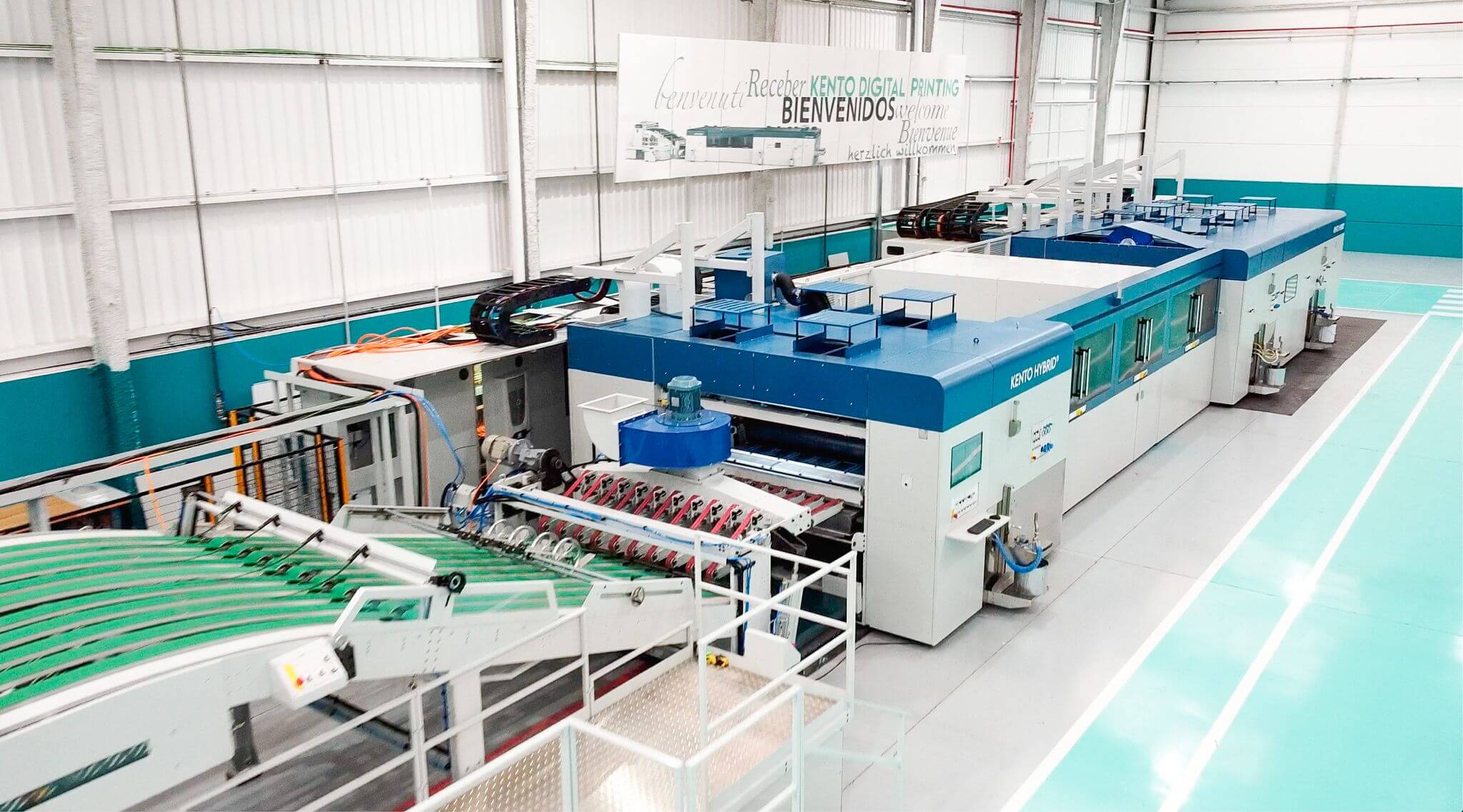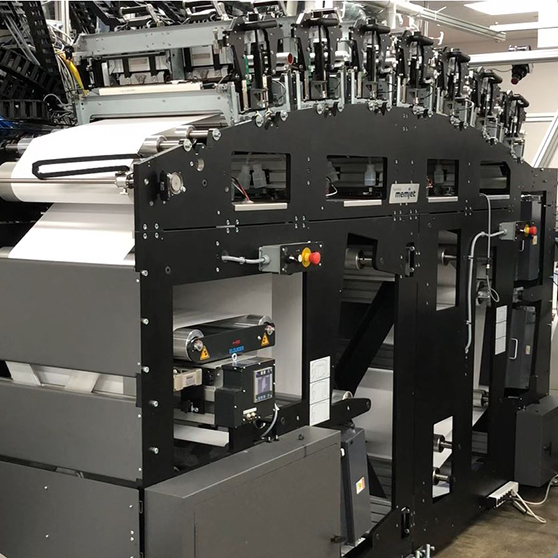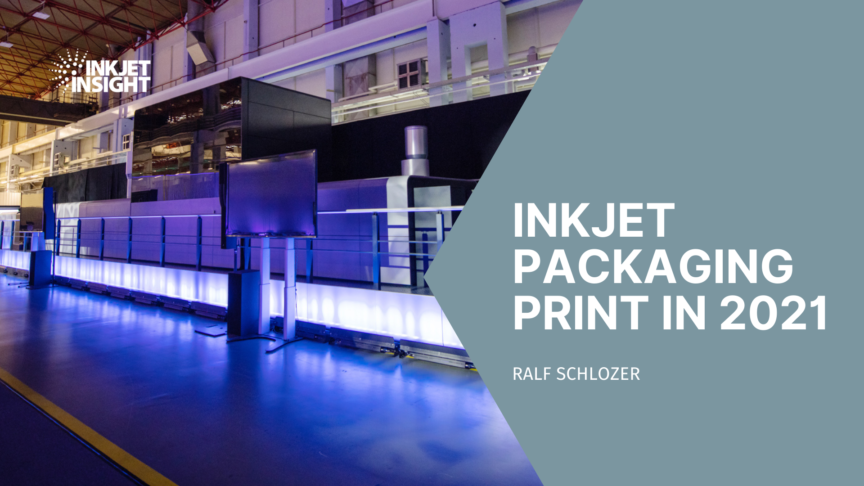Labels
Label printing is the packaging market segment where inkjet printing is most established, with full colour devices available for more than 10 years now and a wide range of presses available. Launch activity continued in 2021, although at a somewhat lower pace, indicating a more mature market. The lack of major trade events in 2021 did not help in hurrying vendors to get out more models.
A newcomer to the label inkjet market is Fujifilm. The company launched the LP350/230 in 2021. Two widths are available with 9” (230 mm) or 13.8” (350mm) and a 50 m/min (164 fpm) speed. The printer uses UV inks and has an option for 6 colours or 2 white channels. Heads and transport are sourced from a partner, with Fujifilm adding the DFE and connectivity. The LP350/230 will be available early 2022 in the US and soon after in Europe and Asia.

Fujifilm LP350 label press
Xeikon remains very active in listening to the market and improving their model range. In 2021 the company upgraded their label offerings as well. Besides two new toner presses (the mid-volume CX30 and Xeikon CX50) new Panther 2.0 UV inkjet models were launched: the Xeikon PX2200 and Xeikon PX3300. Thy are replacing the PX2000 and PX3000. The new models sport a number of improvements that allow for more substrates and higher quality. Also, the X-800 DFE got an upgrade and Xeikon’s new interface also mean that the Xeikon PX2200 and PX3300 can communicate with other equipment, such as the company’s finishing and embellishment units. Both models are now commercially available in Europe and North America
The launches in 2021 fall within the mainstream of UV inkjet presses in the 220 and 330 mm width and 50 m/min speed, where most demand – and competition – takes place. Other vendors kept adding smaller improvements to their devices as well, ensuring that there is ample choice in competitive devices for users.
Flexible Packaging
2020 already saw the launch of several flexible packaging inkjet presses. The momentum continued in 2021. Considering that a few years ago there were practically no inkjet systems available, the market changed dramatically. Keep in mind that even of the systems launched last year only a few beta installations exist. The models launched in 2021 will have an equally long ramp-up.
The Truepress PAC830F is the latest addition to the SCREEN inkjet portfolio and moves the company into flexible packaging. With a printing speed of 75 m/min (246 fpm) for materials of up to 830 mm width and with a resolution of 1,200 dpi, the Truepress PAC830F is a quite productive flexible packaging printer and like most other flexible packaging inkjet presses complements flexo installations for lower run lengths. Accordingly, the press is targeted to use the same substrates as flexo presses and offers the same converting options. The press is using water-based inks for CMYK and white, with a new technology that promises opaque white in one hit. A primer is used to allow for a good adhesion for the aqueous inks used. A first install was planned for December 2021 in Japan. Worldwide availability is expected for 2022. Unlike other inkjet presses offered, the PAC830Fwill be sold by SCREEN only.

Screen Truepress PAC830F
The FP790 isn’t Fujifilm’s first foray into flexible packaging printing with inkjet. The 540WV – also named EUCON for the technology used – has been presented in 2016 and several presses have been placed in Japan. The technology uses UV inks and while having some success in Japan the UV ink technology did not prove to be suitable for U.S. and European customers. On the basis of the 540WV the FP790 was developed. Crucially now aqueous inks are used. The press has a 1200 x 1200 dpi resolution, using Samba heads, a top speed of 50m/min and a maximum substrate width of 790 mm. Using a CMYK ink set, the press is claimed to hit more than 90% of the Pantone colour gamut. With two white ink channels a good white opacity should be achieved. As the product is still in an early launch phase, Fujifilm is not divulging too many products specifics. The first beta press will be installed at a U.S. customer early 2022. First devices for European and other parts of the world will be shipped later in 2022.
The upcoming offerings of Comexi are a bit more comprehensive. Comexi is an Italian manufacturer of flexo presses for packaging. At virtual drupa 2021 in April the company announced their first digital offerings. The Digiflex inline inkjet bar is designed to give flexo presses, laminators and slitters already installed an imprinting option. Besides numbering and coding, large areas should be possible as well, although the Digiflex is likely only complementing flexo print with some variable images. Due to space restraints in existing lines the company is using UV inks, which likely limits the application range. There will be a dedicated flexible packaging inkjet press as well. The Comexi D4 inkjet press uses water-based inks in contrast to the Digiflex. It will be configurable from 4 to 8 colors with CMYK plus OGV and white. This press will print at a high- and low-resolution speed of 75 m/min (246 fpm) and 150 m/min (492 fpm), respectively. In both systems development partners are Sun Chemical for inks, Fujifilm for inkjet heads and Meteor Inkjet for integration. The Digiflex was announced to go beta this summer however no installations became known so far. The D4 is still more than a year out.
The new launches fit well into what is becoming the mainstream of inkjet flexible packaging presses with a speed around the 75 m/min mark, 80 cm width, high imaging resolution and using aqueous inks. They don’t come cheap and are targeted at established converters which want to offload short runs from their flexo presses.
Folding Carton
Dedicated launches in inkjet folding carton presses have been sparse, despite several prototypes and announcements made at drupa 2016. A major hinderance is the B1 format that is essentially required for efficient folding carton production coupled with very high quality requirements.
Also, the Koenig & Bauer VariJET 106 concept was originally presented at drupa 2016. However, it took some time and a new partner, Durst, to complete the development for a launch in September 2021. The VariJET 106 is a 7 colour aqueous inkjet press in B1 format. Feeder, delivery, sheet transport, priming and varnishing units are Koenig & Bauer developed and are based on the Rapida 106. The inkjet imaging unit is provided by Durst, and so are inks, workflow and RIP. With a 1,200 by 1,200 dpi resolution the Dimatix Samba heads produce a stunning quality. The press has a primer and a varnishing unit as a standard. Potentially other printing and embellishing units can be added in the future. The first device will be installed at an unnamed beta site early 2022. Full availability is planned for end of 2022 or early 2023.

VariJET 106
Despite Heidelberg pulling out of the B1 folding carton inkjet market Koenig & Bauer is optimistic to have the right combination of a higher speed and lower running costs to attract converters. Targeted are runs up to 5,000 sheets and the aim is to offload unprofitable short-runs from offset presses to print them profitable on the VariJET 106.
The VariJET 106 is not a small press and not for everyone’s budget. Given the lack of short run solutions in the B1 format (there is the Landa S10 as well) for a market needing short runs and quick turnaround there should be good interest in any B1 digital press offering high quality and good productivity on folding carton substrates.
Corrugated
2020 saw several launches and now products are starting to get shipped. For example, US company TriState Container Corporation became the first business to install Xeikon’s new Idera single-pass corrugated inkjet printer in 2021. The number of launches slowed a bit in 2021, still there was good activity.
HP has upgraded the T1100 series to the HP PageWide T1195i Press. New HP Thermal Inkjet printheads are used on the 2.8m (110-inch) wide press. Base specifications are unchanged but according the HP are designed to deliver more robust and economical production for roll-fed press. Georgia-Pacific’s Hummingbird will be the first to deploy the new HP PageWide T1195i Press at a new Phoenix, Arizona site.
A bit under the radar is a new player in corrugated inkjet presses joined the market in 2020. Spanish company Kento launched the Kento Hybrid press, a system combining inkjet and flexo stations. A single-pass inkjet printing unit prints the short run colour images, while one or more flexo units can be used for printing backgrounds or spot colours. Kento is a newly founded company, focusing on the new press. The press support sheet formats up to 2.1m x 1.3m are and a linear speed of 80 m/min (262 fpm) or 9,000 sheets/hour. UV-inkjet is used with 360 dpi in 4 grey levels. Kento expects substantial ink savings in operation when replacing inkjet ink with flexo inks.

Kento Hybrid press
As most inkjet presses launched, the Kento Hybrid press is targeted for larger printers with sufficient space and invest and the opportunity to move some existing work to a short run press. However, exceptions exist. One is the PKG-675i from Konica Minolta, which was brought to Europe in 2021. The device is targeting the entry level market with an invest below €200k. There is also less automation and throughput to be expected. Nevertheless, the Memjet heads offer a high imaging resolution and the device is very compact. EFI, well established with the Nozomi in corrugated went for the entry market as well with the new MCORR. As the Nozomi, the MCORR uses UV inkjet, however as a scanning head device. With about a sixth of the throughput and a smaller format the MCORR is more an affordable, entry model compared to the Nozomi. The same ink set, options for orange, violet and white and the same colour space do make the output quite comparable. Both, the PKG-675i and the MCORR 1300 deserves a closer look as they could appeal to start-ups and smaller printers, potentially bringing digital print capabilities closer to the goods and packaging producers.
And more
This “short” overview includes only the 2021 launches in the main packaging markets. There are many specialty applications not covered here like new offerings from system integrators – which can be customised. Other possibilities are adding inkjet heads to other pieces of equipment. For example the Paper Converting Machine Company (PCMC), part of Barry-Wehmiller, has announced the launch of its ION digital conversion system. The ION is an add-on to converting lines using Memjet’s DuraLink technology. The flexible modules that can be configured from 8.5” print to 60” and from monochrome to full colour.

ION converting system
A mention should be given to the new plant-based inkjet ink from Ricoh. The oil-based ink is targeted at packaging markets where absorbent substrates are used. The component of the ink is soybean oil. Without the need for drying, a high yield, no odour and good deinkability, the ink can bring some interesting environmental benefits.
Inkjet for packaging will remain a lively market for news and launches in the years to come. While there is less innovation expected in the mature label printing market, the other markets are brimming of launches. Opportunities for short-run and just-in-time production are great, but the systems will need to prove themselves as well in harsh production environments. Tweaks and upgrades will be necessary; however, I am expecting the uptake to increase rapidly.

